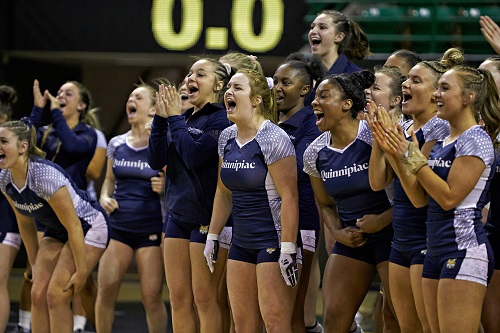
In May, news broke that NCAA Divisions I, II and III will sponsor legislation to add STUNT, a competitive, cheer-based athletic program, as an emerging sport for women. The legislation will be voted on at the January 2023 NCAA convention.
At the same time, another sport, Collegiate Acrobatics & Tumbling, is already on the Emerging Sports list (it was added in June of 2020). What are the differences? What are the similarities? What should potential hosts know?
First, the basics. Acrobatics and tumbling is a program of the National Collegiate Acrobatics & Tumbling Association (NCATA) and USA Gymnastics sanctions all competitions (Acrobatics & Tumbling is a discipline of USA Gymnastics). For a profile of NCATA and its events, click here.
STUNT was developed by USA Cheer, the national governing body for competitive cheerleading in the USA. STUNT is an emerging sport under the California Interscholastic Federation (CIF). For a profile of STUNT and its events, click here.
Both sports use skills and elements found in cheer, without the crowd-leading aspect. (In this respect, they are similar to all-star cheer programs, which are private gym-based programs that are not affiliated with a school; however, they are both college-centric and team-based sports that are aimed at providing opportunities for female athletes to use their cheerleading background in a competitive format after high school).
Program formats for each sport differ, however:

NCATA: Two or three teams may compete at once. Meets are divided into halves, each having three events. The first half consists of Compulsories, Stunt and Pyramid. The second half includes Basket Toss, Tumbling and Team Routine. Some skills performed are predetermined while others must meet certain criteria.
STUNT: Two teams compete head-to-head. Meets are divided into quarters. The first quarter is Partner Stunts, in which teams compete simultaneously on the mat. Group Jumps & Tumbling are performed in the second quarter, and teams compete individually. The third quarter consists of Pyramids/Tosses, and here, teams compete simultaneously. The fourth quarter is the Team Routine, in which teams compete individually. All skills performed, with the exception of Team Routine, are predetermined.
In STUNT, the team that is judged to have executed the skill best is able to win the round and the point and can determine which routine level will be called next.
Both sports are currently engaged in making the climb to the requisite number of 40 varsity programs to move forward to the NCAA governance structure for championship consideration.
STUNT, whose list of participating schools can be found here, has 37 varsity programs.
NCATA, whose list can be found here, is also growing.
"We currently have 43 programs who are sponsoring varsity Acrobatics & Tumbling," notes Janell Cook, executive director. "We are expecting other announcements this month, so we may be at 44 soon. To be eligible for championship status, 40 teams must reach NCAA sport sponsorship levels (minimum number of participants and competitions). We're working to get those programs that have recently announced up to speed!"
The NCAA Committee on Women’s Athletics is charged with identifying and managing progress of emerging sports for women. An emerging sport is a women’s sport recognized by the NCAA that is intended to help schools provide more athletic opportunities for women and more sport-sponsorship options for the institutions, and help that sport achieve NCAA championship status.
When the NCAA adopted the recommendations of the Gender Equity Task Force in 1994, one of the recommendations was the creation of the list of emerging sports for women. Nine sports were on that first list. In the past 21 years, some have become championship sports (beach volleyball, rowing, ice hockey, water polo and bowling), while others have been added to or removed from the list.
In addition to Acrobatics & Tumbling (and eventually, STUNT), current programs on the Emerging Sports for Women list (and the organizations working toward their adoption) are as follows:
- Equestrian (Divisions I and II only)
- Rugby
- Women’s wrestling
Bylaws require that emerging sports for women gain championship status (i.e., minimum 40 varsity NCAA programs for individual and team sports; with the exception of Division III requiring only 28 varsity programs for team sports) within 10 years or show steady progress toward that goal to remain on the list. Institutions may use emerging sports to meet minimum sports-sponsorship requirements and, in Divisions I and II, minimum financial aid requirements.
The most recent sport to reach 40 programs, and be eligible to achieve championship status, has been women’s triathlon, which hit its 40-school mark in February.
“Triathlon now has a few more steps to take on its way to being fully managed by the NCAA as a Championship event, including committee, council, divisional and budget approvals,” noted USA Triathlon’s Stephen Meyers in an article in SDM. “These details will be worked out, and USA Triathlon will continue to add more programs to grow the sport at the collegiate level.”
